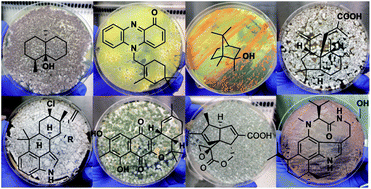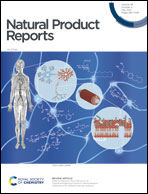Bacterial terpenome†
Abstract
Covering: up to mid-2020
Terpenoids, also called isoprenoids, are the largest and most structurally diverse family of natural products. Found in all domains of life, there are over 80 000 known compounds. The majority of characterized terpenoids, which include some of the most well known, pharmaceutically relevant, and commercially valuable natural products, are produced by plants and fungi. Comparatively, terpenoids of bacterial origin are rare. This is counter-intuitive to the fact that recent microbial genomics revealed that almost all bacteria have the biosynthetic potential to create the C5 building blocks necessary for terpenoid biosynthesis. In this review, we catalogue terpenoids produced by bacteria. We collected 1062 natural products, consisting of both primary and secondary metabolites, and classified them into two major families and 55 distinct subfamilies. To highlight the structural and chemical space of bacterial terpenoids, we discuss their structures, biosynthesis, and biological activities. Although the bacterial terpenome is relatively small, it presents a fascinating dichotomy for future research. Similarities between bacterial and non-bacterial terpenoids and their biosynthetic pathways provides alternative model systems for detailed characterization while the abundance of novel skeletons, biosynthetic pathways, and bioactivies presents new opportunities for drug discovery, genome mining, and enzymology.



 Please wait while we load your content...
Please wait while we load your content...